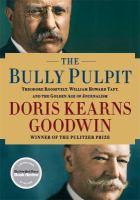
In The Bully Pulpit, Doris Kearns Goodwin discusses the Progressive Movement through the eyes of three principal actors—Theodore Roosevelt, William Howard Taft, and Samuel S. McClure—along with the remarkable contributors to McClure’s Magazine, notably Ida Tarbell, Ray Stannard Baker, Lincoln Steffens, and William Allen White.
As in her previous histories of Lincoln, the Fitzgeralds and the Kennedys, and Lyndon Johnson, Kearns Goodwin provides rich descriptions of the relationships among the many players in her books. This makes her writing so much more compelling than histories that merely describe chronological events. In Bully Pulpit, she weaves the story of the endearing friendship of Roosevelt and Taft during their long careers and the rift that developed during the election of 1912. Despite losing his re-election bid to Woodrow Wilson, Taft remarked that the worst part of the election was losing his best friend, Roosevelt, in the process.
Kearns Goodwin creates a tapestry of relationships among Roosevelt, Taft, and the McClure’s journalists as they promote their common causes of social, economic, and environmental justice at the turn of their century. All of these themes speak poignantly to today’s readers as we deal with the modern rendition of The Gilded Age. Despite the heartbreaks, Kearns Goodwin leaves the reader with a happy ending. The Bully Pulpit is a satisfying history of an era that speaks to us today and is a worthy recipient of the Pulitzer Prize.
